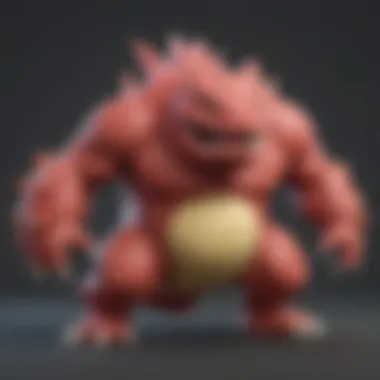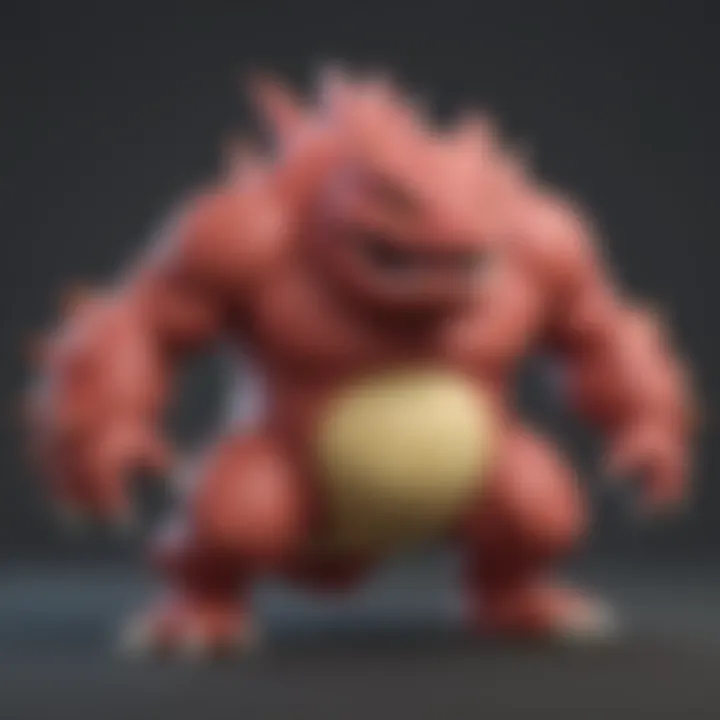Understanding Pokémon Bulk in Competitive Gameplay


Intro
In the vast world of Pokémon, strategy takes center stage, especially in competitive play. A key element that often gets sidelined yet is paramount in battles is the concept of bulk. Bulk, generally speaking, refers to the defensive capabilities of Pokémon, which can significantly sway the tide of battle. Knowing how to harness bulk can elevate a player’s strategy from basic to brilliant. But what exactly constitutes bulk, and why should trainers invest time in understanding it?
As Pokémon aficionados, we often lean towards speed and offensive might, believing that crushing opponents quickly is the surefire way to victory. However, as any seasoned player will tell you, the game can turn on a dime. That’s where bulk comes in. It can frustrate opponents, stall aggressive plays, and ultimately lead to surprising victories.
Let's break down the key facets of Pokémon bulk, the defensive mechanics at play, and why it should be a cornerstone of any competitive team composition.
Pokemon Game Overview
The journey of Pokémon began in 1996, and since then, it has evolved in more ways than one. Those pixelated creatures have undergone a transformation that kept the players hooked.
History of Pokemon games
From its inception, Pokémon has offered intricate gameplay mechanics. The original Game Boy titles showcased a simplistic turn-based battle system, but as new games rolled out, the complexity expanded. Pokémon Red and Blue, for instance, introduced the foundation of catch-and-battle mechanics, while Gold and Silver added the day-night cycle and two regions to explore.
Evolution of gameplay mechanics
As we ventured deeper into the world of Pokémon, game mechanics grew richer. By incorporating abilities and held items, the competitive edge sharpened. Imagine a battle where not only the Pokémon's stats matter but also how they interact with the environment and their opponents. These changes prompted players to rethink traditional strategies, introducing a layer of depth that molded gameplay.
Prelude to different game versions
With each generation, we have the opportunity to experience unique features. From the bustling streets of Hearthome City in Diamond and Pearl to the vast wilderness of Alola in Sun and Moon, trainers are met with varied landscapes and gameplay styles. Every game version has its own nuances that can influence a player’s approach to battles.
Tips and Strategies
When it comes to mastering Pokémon battles, having solid tips can make a world of difference. Whether you are just starting or looking to hone your advanced strategies, there’s always something new to learn.
Beginner's guide to Pokemon games
For new trainers, focus on building a balanced team. A mix of attackers and defenders will give you the flexibility needed in various encounters. Plus, understanding type advantages will keep you a step ahead in battles.
Advanced gameplay tactics
Once you get a hang of the basics, it’s time to delve into the layers of tactics. One significant aspect to consider is predicting your opponent's moves based on their Pokémon's bulk. Knowing when to switch Pokémon or set up defensive strategies can harness bulk effectively.
Team building strategies
Creating a cohesive team involves considering synergies among Pokémon. Pairing bulky Pokémon like Snorlax or Blissey with faster sweepers can create opportunities for sweep attacks while utilizing the bulk for protection.
Character Spotlights
In the arena of competitive play, certain Pokémon stand tall, revered for their bulk.
Featured Pokemon profiles
- Togekiss: Known for its fairy- and flying-type advantages, Togekiss boasts a solid amount of bulk, making it capable of surviving hits while retaliating with strong special moves.
- Ferrothorn: With its incredible resistance to common attack types, Ferrothorn can be a wall that opponents struggle to break through.
Analysis of popular characters
The effectiveness of characters like Gyarados or Dragonite isn’t solely reliant on attack stats. Understanding their bulk can be a game changer in utilizing them during matchups against heavier hitters.
Impact of characters on gameplay
The Pokémon you choose can shape your battle strategy. Bulkier Pokémon can absorb substantial damage, allowing players to set up traps and prepare counter-measures, leading to the overall strategic lengthening of battles.
Latest News and Updates
Staying tuned with recent developments can provide an edge in competitive play.
Recent game releases
With the latest Pokémon Scarlet and Violet introduction, players have new mechanics and Pokémon to explore. This can shift the meta in competitive circles, making it vital to adapt quickly.
Patch updates and events
Keeping an eye on patch notes is crucial. Updates can tweak stats of Pokémon, which can alter how bulk factors into competitive play.
Rumors and speculations
In the dynamic realm of Pokémon, whispers of upcoming characters or changes can circulate among fans. This phase can excite the community and often leads to speculations about how new mechanics may interact with existing strategies.


Defining Bulk in Pokémon
In the realm of competitive Pokémon, the term "bulk" refers to a Pokémon's ability to withstand damage, both physical and special. It's a crucial element that differentiates between Pokémon that can endure long battles and those that can't. Understanding the intricacies of bulk can lead to more informed team-building decisions, allowing players to weave resilience into their overall strategy. Bulk isn’t just a number; it's a game-changer in many high-stakes matchups that can turn the tide in a trainer's favor.
Understanding Base Stats
The bulk of a Pokémon is largely determined by its base stats, specifically HP, Defense, and Special Defense. These three stats serve as the backbone for a Pokémon's endurance in competitive settings. Base stats are set values that define how strong a Pokémon can be in various areas, and they are categorized into offensive and defensive capabilities. A higher base HP means that the Pokémon can take more hits before fainting, while better Defense and Special Defense stats allow it to mitigate damage from physical and special attacks, respectively.
When evaluating a Pokémon’s potential bulk, one might consider a few key factors: 1) How its stats compare to the average within its tier, 2) Whether it has access to moves that can enhance its defense or health recovery, and 3) How it operates in synergy with other team members. For example, a Pokémon like Blissey, known for its exceptionally high HP, can serve as a wall that absorbs damage, making it a staple choice in many teams.
HP, Defense, and Special Defense Explained
HP, Defense, and Special Defense are the triad of metrics that collectively dictate a Pokémon’s bulk. Let’s break these stats down more clearly:
- HP (Hit Points): This reflects the total amount of damage a Pokémon can take before fainting. A strong HP stat enables Pokémon like Chansey to outlast attackers, often requiring multiple hits to bring them down.
- Defense: This stat assesses a Pokémon’s resilience against physical moves. A formidable Defense stat allows Pokémon such as Ferrothorn to shrug off even the fiercest of physical hits, making it a tough adversary on the battlefield.
- Special Defense: This measures how well a Pokémon can withstand special attacks. Notables like Mimikyu or Sableye thrive here, as they can stand up to powerful special attackers with their enhanced Special Defense capabilities.
In terms of competitive play, balancing these stats can be a tricky endeavor. Trainers often have to make nuanced decisions about which aspects of bulk to prioritize based on their team composition and the current meta.
"Understanding how each stat contributes to a Pokémon's overall bulk can help trainers devise strategies that enhance survivability without sacrificing offensive potential."
Ultimately, recognizing the strengths and weaknesses of each stat informs strategic decisions, helping players craft defensive setups that catch opponents off-guard. It’s a dance of numbers where every calculation could mean the difference between claiming victory or facing defeat.
The Role of Bulk in Competitive Play
In the realm of competitive Pokémon battles, bulk stands as a crucial pillar that warrants extensive exploration. The importance of bulk can be dissected into several layers, notably survivability, the interaction with offensive strategies, and its overarching influence on match dynamics. Understanding these elements not only enhances a player’s strategic depth, but also refines their responsiveness to opponents’ moves.
Survivability vs. Offensive Strategies
When it comes to building a competitive team, the age-old debate between survivability and offensive strategies takes center stage. Players often grapple with the decision of allocating resources to enhance a Pokémon's bulk versus ramping up its offensive prowess. Bulk-focused Pokémon, often characterized by elevated HP, Defense, and Special Defense, serve primarily to absorb hits and prolong their participation in battle. For instance, Blissey, renowned for its extraordinary HP, can take multiple hits before bowing out, offering teammates the chance to recover or deal damage.
On the flip side, an offensive powerhouse, such as Garchomp, thrives on delivering heavy blows swiftly. A balance often emerges between the two philosophies—bulky Pokémon can outlast powerful attackers, while offensive Pokémon can pressure defensively-oriented teams from the get-go.
This balance is not merely theoretical; it demands a careful analysis of team composition and individual match-ups. Players should evaluate the possible scenarios in which bulk can mitigate damage, especially against prevalent threats, and strategically select defensive moves to prolong their Pokémon's life in battle.
"In Pokémon, sometimes it's not about who hits hardest but who can take the hits the longest."
The Impact of Bulk on Match Outcomes
The ramifications of Pokémon bulk extend beyond individual battles; they can sway entire match outcomes. Let’s consider a scenario where a player utilizes a defensively-built Ferrothorn. With its dual Grass and Steel typing, coupled with remarkable resistances, Ferrothorn can effectively counter multiple offensive threats. Its access to moves like Leech Seed and Stealth Rock emphasizes its role as a defensive pivot. Consequently, Ferrothorn not only absorbs damage but also enables its team to control the flow of battle.
Moreover, bulk can create openings for decisive moments in a match. Whether it’s forcing an opponent to overextend or baiting them into a move they didn’t intend, sturdy Pokémon can exploit these situations. Players may find that a well-placed Reflect or Light Screen can capitalize on their bulk, setting the stage for a comeback or a strategic counteroffensive.
Additionally, bulk influences various gameplay aspects. It shapes a player’s choice of moves, dictates how they handle particular threats, and informs their prediction strategies. While a beautifully executed offensive strategy can lay waste to opponents, being robust enough to absorb a hit or two often proves advantageous and can lead to unexpected victories.
In summary, understanding how bulk operates and its significance across diverse strategies can transform a player's approach to competitive play. Bulk is not merely an afterthought; rather, it is a foundational element that influences tactics, team construction, and ultimately, outcomes in the heated arena of Pokémon battles.
Key Pokémon with Notable Bulk
In the realm of competitive Pokémon battles, the concept of bulk stands out as an essential element in a player's strategy. Some Pokémon are distinguished by their impressive bulk, allowing them to withstand attacks that a less durable Pokémon would easily succumb to. Understanding which Pokémon possess notable bulk enables players to make informed choices about their team compositions and strategies. Moreover, these bulkier Pokémon can be pivotal in stalling opponents or soaking up damage while setting up or executing other plans.
Analyzing Popular Bulk Pokémon
When talking about heavy hitters in the bulk department, a few names immediately spring to mind. Togekiss, for instance, blends high Special Defense with a diverse movepool, making it a formidable opponent. Players regularly note its ability to take hits while dishing out status effects or powerful Fairy-type moves. Similarly, Ferrothorn's incredible Defense makes it a stalwart in defense, capable of absorbing blows while threatening with its powerful Steel-type attacks.
Let’s not forget Blissey, noted for its ludicrously high HP. It’s the type of Pokémon that can remain on the field for many turns, shrugging off physical and special attacks alike. With the right support and moveset, it can become a wall that opponents find incredibly difficult to break through.
These Pokémon serve as excellent examples, showcasing how bulk can shape strategies. Whether you are using them to absorb damage, spread statuses, or simply serve as a tank in your team composition, the benefits are clear.
- Togekiss: 85 HP, 50 Defense, 105 Special Defense
- Ferrothorn: 74 HP, 131 Defense, 116 Special Defense
- Blissey: 255 HP, 30 Defense, 70 Special Defense
Comparing Stat Distributions
To gain a deeper understanding of bulk, it’s important to analyze the stat distributions of Pokémon known for their durability. Stat distribution is a term that refers to how the various stats—such as HP, Attack, Defense, Special Attack, Special Defense, and Speed—are allocated to a particular Pokémon.
One cannot just look at raw HP numbers; looking at a Pokémon’s entire stat distribution provides better context. For example, Snorlax has high HP (160), balanced with good Attack (110) and decent Special Defense (75). In contrast, if we observe Sableye, it possesses lower HP (50) but has a unique blend of 75 Defense and Special Defense, creating a different style of bulk.
When comparing these two, one might conclude that Snorlax can outlast opponents longer in endurance fights, while Sableye can effectively resist diverse types of damage, particularly due to its immunity to Normal and Fighting-type moves. This goes to show the nuances of bulk: it isn’t solely about high numbers in one area but balancing stats effectively to cater to a player's specific strategy.
As you consider your team composition, think about how these distributions impact overall defensive viability. Pokémon with high HP but lacking Defense can occasionally be overwhelmed by powerful physical attacks, while those like Sableye can thrive against Special Attackers thanks to their unique stat allocation.
“Choosing bulky Pokémon is finding the right balance in stats and moves; it’s not just about standing there and taking hits.”
Building a Bulky Team


When it comes to competitive Pokémon battles, having strength and speed alone often doesn't cut it. That's where building a bulky team kicks in. A team that focuses on bulk can be a different kind of powerhouse, designed to withstand powerful hits while providing ample opportunities for counterplay. The benefits of a bulky team are manifold; you can outlast opponents, create openings for your strategies, and, ultimately, control the pace of the match. But let’s dig deeper into how to craft such a team and why it can be incredibly advantageous.
Selecting Pokémon for Bulk
Choosing the right Pokémon to comprise your bulky team is a critical step. Not all Pokémon are created equal in this respect—some have inherent defensive prowess. Here are aspects to consider:
- Base Stats: Focus on Pokémon with high base HP, Defense, and Special Defense. These stats are your front line against interruption from especially strong opponents.
- Typing Synergy: A well-rounded typings can turn a good bulk Pokémon into a tremendous one. For instance, Steel-types often have solid resistances, mitigating damage from several common threats. Consider using Pokémon such as Ferrothorn or Skarmory which exemplify this principle.
- Movepool: It’s not just about raw stats; the moves a Pokémon can learn often determine its bulk utility. Pokémon with access to moves like Recover, Roost, or other healing methods should be valued highly. This is vital for sustaining pressure during long matches.
- Meta Considerations: Depending on the current battle meta, different Pokémon will shine or fade. Ensure you have a good understanding of what's being used frequently. Pokémon like Togekiss, with its decent bulk and access to useful status moves, can provide excellent utility—especially in a Special Defense role.
Balancing Bulk with Other Traits
Building a bulky team isn’t just about loading up on defensive stats. Balancing bulk with other essential traits can create a much more versatile team. Here are some considerations:
- Speed: While bulk is vital, too much reliance on it can lead to sluggish teams that struggle to respond to threats. Having a few faster Pokémon can allow you to execute knockouts before the opponent can retaliate. This balance often requires tricky foresight during team selection.
- Offensive Presence: A team that's entirely defensive can allow the opponent to set up comfortably. Including bulk Pokémon with decent offensive moves can keep your opponent on their toes. Something like Gardevoir has good bulk while providing offensive pressure with Fairy and Psychic-type moves.
- Status Conditions: Sometimes, sheer bulk isn’t enough. Incorporating offensive and debilitating status effects, like burn or paralysis, can turn the tide of battle. For example, using Pokémon like Gengar to spread Toxic can complement a bulky core by wearing down other threats quickly.
- Team Composition: Finally, think about team roles. Mixing offensive and bulk roles ensures that there's flexibility in how battles can unfold. A strategy where a bulky wall like Blissey can soak damage while something snappy like Dragapult can come in and take advantage is often a winning combination.
Crafting a bulky team requires strategy, insight into the game mechanics, and a good awareness of current trends. A one-size-fits-all approach won’t serve you well, but a balance can carry you through intense battles.
By focusing on these elements and ensuring that each Pokémon fits a role that highlights its strengths while making allowances for weaknesses, you can carve out a unique position in competitive play that relies on the enormity of stamina and strategy rather than merely speed.
Impact of Meta on Bulk Usage
The metagame in Pokémon isn’t just a buzzword; it's the ever-shifting landscape of competitive play. When we talk about bulk, understanding the meta’s influence is key. Bulk isn’t static; it evolves as new strategies, Pokémon, and balancing updates hit the scene. A Pokémon’s survival can depend not just on their individual bulk but on how that bulk stacks up against the broader metagame.
Evolving Metagames and Bulk's Relevance
In each generation of Pokémon, we see the metagame shift dramatically. This can be due to the introduction of new Pokémon or changes in game mechanics which alter how players approach battles. For example, when Mega Rayquaza burst onto the scene, the playstyle adapted. Many trainers began to prioritize Speed and Immediate Damage Output over sheer bulk, shifting the focus to offensive strategies. This example illustrates how evolving characters in the metagame can sometimes diminish the value of pure bulk. However, old standbys like Ferrothorn or Chansey, known for their extraordinary defenses, often find themselves relevant due to their ability to check newer threats.
So, bulk remains relevant but fluctuates in value depending on what others are fielding. With the rise of powerful offensive threats, there may also be a resurgence in stall-type teams that prioritize bulk. You can think of it like a seesaw, constantly balancing as trainers react to the current roster of viable Pokémon.
Adjusting Strategies for Current Trends
When the metagame shifts, you have to flex with it. Adapting your strategical game plan based on current trends is paramount. When players are focusing on high-attack Pokémon, a bulky defensive wall can create challenges for those relying on brute force. In contrast, if speedy sweepers rule the roost, Defensive Pokémon with high speed might gain a strategic advantage. The goal is to find the sweet spot between bulk and utility in your team.
Additionally, keeping a pulse on online communities such as Reddit can help. Players often share insights on trending team compositions and popular threats, which can adjust how you perceive your bulky Pokémon. A well-timed switch or strategy can often turn tables in battles heavily influenced by the ongoing meta.
"The only constant in Pokémon is change."
As such, trainers who want to leverage bulk must be willing to rethink their approach, not just once but continuously, as the metagame twists and turns. This proactive mindset ensures that you are not just reacting but also setting the pace in competitive play.
Defensive Strategies Incorporating Bulk
When it comes to competitive Pokémon battles, understanding how to harness the potential of bulk can be a game changer. Defensive strategies incorporating bulk not only extend the survival of Pokémon but also dictate how matches unfold. Players must recognize the power imbued in defensive tactics and build on that foundation to create resilient strategies.
Stall Teams and Their Mechanics
Stall teams are quintessential examples of how bulk can be utilized effectively. These teams focus on outlasting opponents by leveraging Pokémon that are primed for defense. The mechanics stand on a simple premise: wear down opponents slowly, using both defensive moves and status conditions.
- Core Concept of Stall: The idea here is to switch in and out Pokémon that can absorb hits while inflicting gradual damage through moves like Toxic or using entry hazards like Stealth Rock. This gradual approach can turn the tide of battle without engaging directly in power plays.
- Key Traits: Pokémon suited for this strategy often have high HP and respectable defensive stats. Take a look at Pokémon like Blissey or Togekiss—these creatures boast substantial bulk, allowing them to stall for time while restoring health or setting status conditions on enemies.
- Limitations of Stall: However, the growth of offensive strategies in the metagame poses challenges for stall teams. When facing Pokémon with exceptionally powerful moves, stall can buckle under pressure. A team heavily reliant on stall must be equipped with adequate counters to powerful attackers.
- Team Composition: A well-constructed stall team might include a mix of tanks and support Pokémon. For example, consider pairing Ferrothorn with Gyarados. While Ferrothorn sets up hazards and absorbs physical hits, Gyarados can disrupt opponents with moves like Dragon Tail to force switches, buying turns for hazard damage.
Overall, the mechanics of stall teams hinge on effective synergy, so a failure to reinforce defensive lines can lead to quick defeat.
Utilizing Defensive Synergy
Defensive synergy plays an essential role in a team’s overall performance. It means leveraging the strengths of different Pokémon to staunchly defend against various threats. Here are key elements to establish effective defensive synergy:
- Type Coverage: A sound defense must cover broad type weaknesses. A water-type Pokémon, for instance, can be complemented by an electric-type to cover any potential gaps.
- Support Moves: Incorporating moves like Wish, Heal Bell, and Protect can keep your team healthy and maintain pressure on opponents. Support Pokémon become the unsung heroes, quietly turning the tables on aggressive teams.
- Rotational Defense: Employing a rotation strategy with Pokémon that can swap in and out allows for maximizing bulk while keeping opponents guessing. Trading hits can confuse foes, forcing strategic misplays.
- Example: Imagine a Gardevoir flanked by a Togekiss and Ferrothorn. Gardevoir can fend off physical attackers with excellent Special Defense while Togekiss adds an extra layer against Fighting-type moves, and Ferrothorn can withstand multiple hits from Fairy-types. This interplay ensures a safety net against common threats.
The Interplay of Bulk and Offensive Playstyles
In the world of competitive Pokémon, achieving a delicate balance between bulk and offensive capabilities can be a formidable challenge. This interplay is essential for constructing a well-rounded team, as it allows a Pokémon not only to withstand hits but also to dish out significant damage while remaining a threat on the battlefield. Selecting the right Pokémon with inherent bulk means that you can afford to take a few hits while dishing out your own, an aspect critical to gaining momentum in battles.
Bulk and Priority Moves
Priority moves serve a crucial role in competitive play, and when combined with bulk, they can substantially tilt the odds in your favor. Understanding how to leverage bulk when utilizing pririty moves can create opportunities your opponent may not anticipate. Pokémon with solid bulk can often survive hits they might otherwise have fallen to, allowing them to strike back first with a priority move.
For instance, a Pokémon like Scizor can make the most of Bullet Punch, a Steel-type priority move. Scizor boasts substantial Attack power, and when it remains sturdy enough to take a hit from a faster foe, it can retaliate before they even have a chance to counter. This dynamic creates immense strategic depth; you can not only withstand early strikes but also ensure your own offensive presence effectively disrupts opponents’ plans.
Notably, some moves with priority can also bypass certain strategies that rely on speed, such as activating Trick Room. When dealt with bulk, Pokémon can become defensive stalwarts, allowing them to endure powerful hits, thus prolonging their effectiveness in the match.
Incorporating Status Effects for Bulk Enhancement


Status effects can produce a remarkable synergy with bulky Pokémon, enhancing their durability and overall utility in battle. Techniques that inflict status ailments, such as Burn or Paralyze, can mitigate damage taken, boost survival rates, and allow your bulkier Pokémon to remain a persistent headache for your opponent.
When considering status effects, Togekiss represents a pertinent example. By utilizing moves like Thunder Wave or Air Slash, Togekiss can not only slow down faster foes but also cause flinch, effectively forcing opponents into a defensive position. Additionally, if Togekiss is subjected to an unfortunate hit, the presence of the Burn effect reduces the opposing Pokémon's Attack capabilities, allowing this Fairy/Flying type to endure longer in combat.
Incorporating status into your strategy, however, requires careful timing and prediction. Ensuing the right moment to apply said effects can build a compounding advantage in battles, allowing Pokénon to endure longer while sapping the life from their adversaries. Thus, enhancing bulk through status effects is a strategy that complements offensive playstyles beautifully, keeping the competitive landscape both engaging and dynamic.
Through the lens of bulk and offensive playstyles, a vivid narrative emerges—one that interweaves strategies of built-in resilience while battling ferocity. Finding that sweet spot allows trainers to craft competitive teams that hold a multitude of tactical options, paving the way for decisive victories on the battlefield.
Best Moves for Bulky Pokémon
When it comes to building a competitive Pokémon team, selecting the right moves for bulk Pokémon can make all the difference in the heat of battle. Bulk in this context refers to a Pokémon's ability to withstand hits while still contributing effectively in combat. The selection of moves plays a pivotal role in defining how well a bulky Pokémon can handle various threats and, at the same time, fortify their stance in fights.
Defensive Moves that Optimize Bulk
Defensive moves are vital as they enhance the natural endurance of bulky Pokémon. They help in maximizing survivability and turn them into walls that can absorb damage. Here are a few noteworthy defensive moves to consider:
- Recover: This move restores a significant portion of a Pokémon's health. Using Recover strategically can maintain a Pokémon's presence in the match for much longer.
- Baton Pass: While not a classic defensive move, it allows a bulky Pokémon to transfer stat boosts to a teammate, which can shift the tide of the battle in your favor.
- Roost: Similar to Recover, Roost helps bulk Pokémon regain health. Furthermore, it can even change a Pokémon's typing temporarily, allowing for unpredictable defensive strategies.
"Employing moves that enhance bulk is not just about existing; it's about thriving through endurance."
These moves can not only prolong the life of a bulky Pokémon but also jigsaw well with the other defensive strategies a team may adopt. Understanding when to use these moves—like anticipating an opponent’s attack—can ensure a bulky Pokémon remains a significant hurdle for opposing players.
Status Moves that Benefit from High Bulk
Status moves are another layer that adds depth to the gameplay of bulky Pokémon. These can help in mitigating damage, altering the battlefield, or even incapacitating foes. Here are key status moves that synergize especially well with bulk:
- Toxic: This move gradually whittles down the opponent’s HP over time, which can be incredibly useful when pitted against fast attackers. The danger here is prolonged, forcing the enemy to plan around the poison.
- Will-O-Wisp: Inflicting burn not only reduces an opponent's attack power but also deals damage over turns. This is particularly effective in countering physically-based attackers, allowing the bulky Pokémon to stand tall against aggression.
- Thunder Wave: While it may not deal damage directly, paralyzing an enemy can slow them down, which is a boon for bulky Pokémon looking to outlast faster threats.
These status moves provide layers of strategy that can pivot the battle's outcome from a simple endurance test into a clever tactical showdown. By leveraging both defensive and status moves, a player can create an atmosphere where their bulky Pokémon dominates not just through power, but through intellect.
Common Mistakes When Using Bulk
In competitive Pokémon gameplay, understanding bulk can certainly tilt the odds in your favor. However, many trainers fall into common pitfalls while trying to maximize bulk in their strategies. Recognizing these mistakes is crucial; the right moves can make or break a battle. Let's delve into the specific elements that trainers should consider to avoid these missteps.
Overvaluing Bulk Over Speed
One of the cardinal sins many trainers commit is valuing bulk over speed. Yes, having a Pokémon that can withstand hits is admirable, but what good is that if it never gets to hit back? In many cases, a Pokémon's speed stat can be the ace up your sleeve.
For instance, take a look at a Pokémon like Alakazam. It won't soak up many hits, but it's lightning-fast and can deal out big damage before the opponent even gets a turn. By placing too much emphasis on bulk, a trainer might miss opportunities to finish off foes quickly.
When building a team, it’s vital to strike a balance. If you stack up on bulky Pokémon without considering their speed, your team can become sluggish. There’s a sweet spot in balancing defenses, but neglecting the importance of speed can turn battles into drawn-out affairs, making you more susceptible to faster opponents. Think about including Pokémon that can strike first and manage to take out threats before they can land a blow.
Neglecting Coverage Moves
Another major faux pas is neglecting coverage moves in favor of strictly defensive options. While having a bulk-focused set is indeed essential, not considering how Pokémon can counter various types is tantamount to combat with one hand tied behind your back.
Take Shuckle, for example. It naturally has astonishing defenses, but if trainers load it up with only defensive moves, it’s ultimately doing next to nothing in terms of damage output.
Trainers often gravitate toward maintaining a wall, but a little offense can go a long way. Sometimes, using a bulkier Pokémon, like Mandibuzz, with moves that cover common threats can keep you safe while giving you the upper hand. A well-rounded move set that accommodates for type advantages can significantly improve a bulky Pokémon's role in a match. For instance, let's say a bulky Water-type uses an electric move—suddenly, it's threatening a Flying-type Pokémon!
In summary, it's essential to incorporate moves that cover multiple types, even when utilizing bulkier options. By expanding your Pokémon's move pool, you increase versatility in battle, leading to higher chances of success.
"Playing safe can be a double-edged sword, especially when it comes to bulk!"
Understanding these common mistakes is half the battle. To excel in competitive Pokémon, trainers must evaluate their choices carefully, ensuring a well-rounded team that can take hits but also effectively deal damage. By sidestepping overvaluation of bulk and carefully selecting coverage moves, trainers can tilt the odds in their favor, making for a more engaging and strategic gameplay experience.
Future Trends in Pokémon Bulk Dynamics
As the Pokémon universe continues to evolve, so do the strategies surrounding bulk in competitive gameplay. The introduction of new Pokémon, as well as changes in game mechanics, are reshaping the landscape of bulk's relevance. Understanding these trends is essential for players keen on staying ahead of the curve. With an ever-shifting metagame, gathering insights into emerging Pokémon and potential shifts in mechanics significantly impacts team composition and strategy formulation.
Potential New Pokémon with Bulk Potential
When exploring the future of bulk dynamics, attention must be directed towards upcoming Pokémon that exhibit promising bulk characteristics. Games like Pokémon Scarlet and Violet have offered glimpses of Pokémon that may not only present unexpected bulk but also alternative abilities that can enhance survivability. Certain types are notoriously known for being bulky, like Steel and Water types.
Some candidates that might feature high bulk include:
- Iono’s Wo-Chien: With its high base stats in both Special Defense and HP, if introduced correctly, it could redefine how we perceive bulky Pokémon.
- Future Evolutions: Many existing Pokémon have vast evolutions, like some Gen I and Gen II. An evolution for Giratina or Gardevoir could pave the way for them to become defensive titans.
- Regional Variants: New forms of older Pokémon, such as regional variants, often come with altered stats. Think about how Alolan Muk offers a new defensive option with access to Poison/Dark typing.
Incorporating these upcoming Pokémon into a competitive roster may provide unique advantages, especially as gameplay trends focus on maximizing bulk. Moreover, players would do well to keep an eye on community discussions and leaks from reliable sources to determine viable options before they are officially released.
Changes in Game Mechanics Affecting Bulk
Game mechanics are crucial to understanding how bulk operates in competitive play. The introduction of new moves, abilities, and changes to existing mechanics can have profound implications. For instance, consider how Dynamaxing changed the landscape—bulkier Pokémon became even harder to take down, given their increased stats. Visioning future mechanics, one might expect:
- Enhanced Status Moves: Moves like Toxic or Will-O-Wisp could evolve, enabling them to deal extra persistent damage to even the bulkiest defenses.
- Ability Shifts: A new mechanic might allow for temporary boosts to defensive stats when a Pokémon is hit, transforming how battles unfold.
- Meta Adaptation: With regular updates, the relevance of bulk can fluctuate. Features which counter bulk (like increased damage from super-effective attacks or move diversity) could emerge, challenging how defensive strategies are structured.
"As competitive Pokémon shifts, understanding and anticipating these changes becomes as vital as the battles themselves."
Staying ahead means not only understanding your Pokémon's current bulk capabilities but also reintegrating that knowledge into how thoughts on bulk evolve with new changes. Success in high-level gameplay often hinges on adaptability; knowing how to exploit potential mechanical shifts and anticipating which Pokémon may dominate the field ensures that you not get left in the dust.







